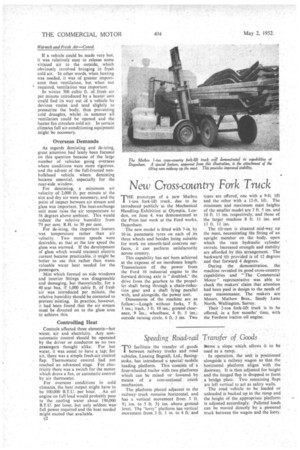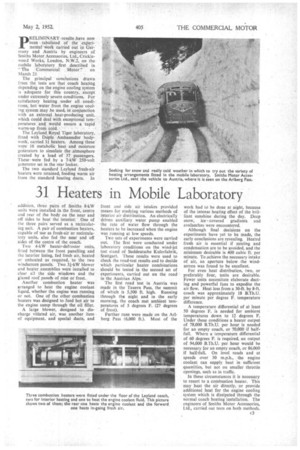Speeding Road-rail Transfer of Goods
Page 40

Page 41

If you've noticed an error in this article please click here to report it so we can fix it.
TO facilitate the transfer of goods between railway • trucks and road vehicles, Lansing Bagnall, Ltd., Basingstoke, has introduced a special mobile loading platform. This consists of a four-wheeled trailer with two platforms which can be raised or lowered, by means of a conventional crank mechanism.
The platform placed adjacent to the railway truck remains horizontal, and has a vertical movement from 3 ft. 91 ins. to 5 ft. lf ins, above ground level. The "lorry" platform has vertical movement from 3 ft. 1 in. to 4 ft. and
forms a slope which allows it to be used as a ramp.
In operation, the unit is positioned alongside a railway wagon so that the horizontal platform aligns with the doorway. It is then adjusted for height and the hinged flap is dropped to form a bridge plate. Two remaining flaps are left vertical to act as safety walls.
The road vehicle to be loaded or unloaded is backed up to the ramp and the height of the appropriate platform is adjusted accordingly. Palleted loads can be moved directly by a -powered truck between the wagon and the lorry.
PRELIMINARY•results have now been tabulated of• the exfierimental work carried out in Germany and Austria by engineers of Smiths Motor Accessories, Ltd., Cricklewood Works, London, N.W.2, on the mobile laboratory first described in
" Tile Commercial Motor" on March 21
The principal conclusions drawn from the tests are that coach heating depending on the engine cooling system is adequate for this country, except under extremely severe conditions. For satisfactory heating under all conditions, hot-water from the engine cooling system may be used, in conjnnction with an external heat-producing unit, which could deal with exceptional temperatures and wouild ensure a rapid
warm-up from cold. -• • The Leyland Royal Tiger laboratory, fitted with Duple Ambassador bodywork', carried 3-1 heaters. Among these were 16 metabolic heat and moisture generators to simulate the atmosphere created by a load of 37 passengers. Thesewere fed by a 7-kW 250-volt generator set in the rear locker.
The two standard Leyland fresh-air heaters were retained, feeding warm air from the standard heating ducts. In Seeking for snow and really cold weather in which to try out the variety of heating arrangements fitted in the mobile laboratory. Smiths Motor Accessories Ltd., sent the vehicle to Austria, where it is seen on the Arlberg Pass.




















































































